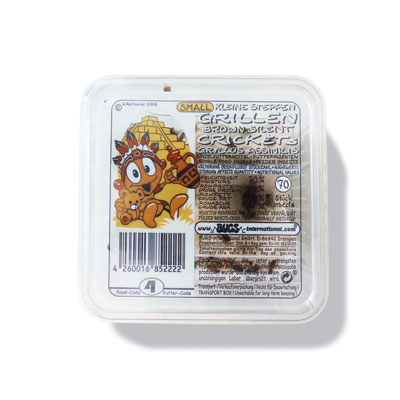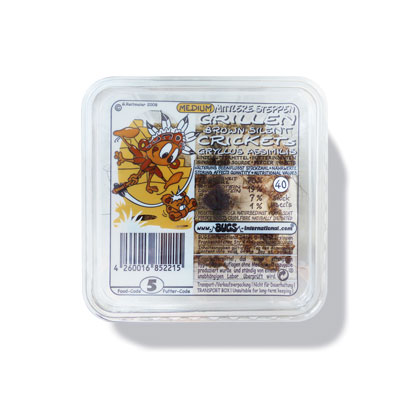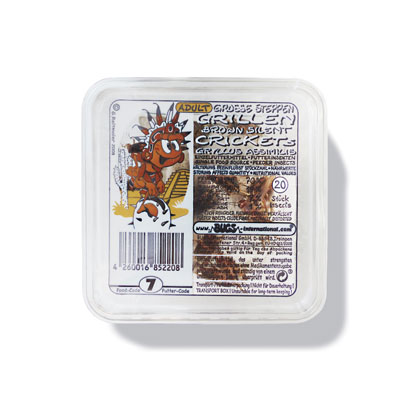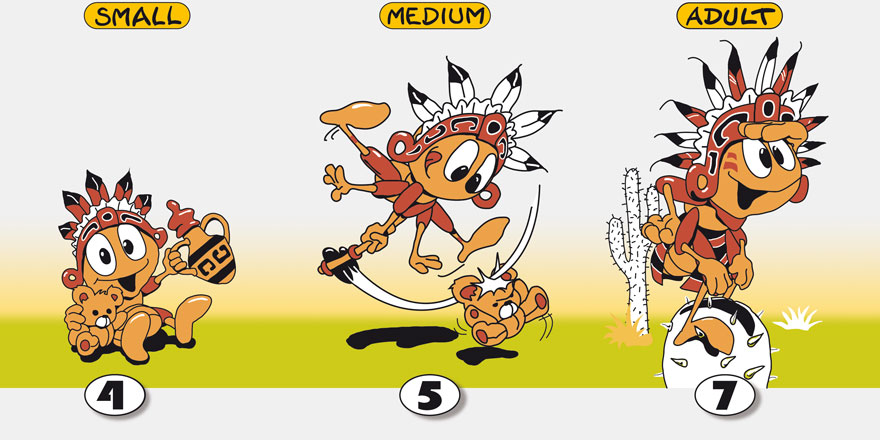
Jamaican field cricket, Brown silent cricket (Gryllus assimilis)
Text: Heiko Werning
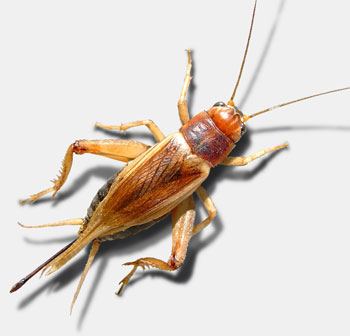
Are you longing for some Caribbean lifestyle? The name „Gryllus assimilis“ doesn‘t make you think that these creatures originate from the Caribbean. Of course, in Central America the species is also widespread. This decent yet still noble cricket can also be found in the south of Florida and Texas. In the face of its natural habitat, the second (German) name of this species, which has fallen out of favour, seems a bit more accurate: the banana cricket was the name previously given to these crickets.
The Jamaican field cricket arrived in our terrariums relatively late. However, it remains less well know as its more prominent cousin, the house cricket and the Mediterranean field cricket. The Jamaican field cricket certainly doesn‘t need to hide behind the Mediterranean field cricket. With its robust stature and noble size as well as the elegant caramel brown tones, the cricket is not just nice to look at, it is also the perfect feeder animal for almost all pets that enjoy eating live prey. The Jamaican field cricket earns top marks because in this combination the insect has a real unique selling proposition under the standard feeding insects. The Jamaican field cricket grows significantly bigger and thicker than the house cricket, is therefore also able to make larger terrarium dwellers happy, such as small monitor lizards, larger monitor lizards, skinks, oscellated lizards, common collared lizard and leopard lizards, large geckos such as the Tokay gecko or New Caledonian giant gecko and giant frogs. Try getting these geckos or frogs really full by only feed them house crickets! Once you‘ve tried doing that, you will really appreciate our large Jamaican field crickets. Even the majority of the insect-eating mammals are really happy if they can pack their claws around something big and juicy. We‘ll leave the big birds out of the equation for now. Lots of other invertebrates enjoy sinking their teeth into the crickets as well as large tarantulas and scorpions
For all smaller pets, the Jamaican field cricket provides a generational buffet: beginning with the ant-sized micro Jamaican field cricket and through all larvae stages to the adult cricket, there is something for every hungry mouth. Even if the hungry mouth likes taking an even heartier bite every now and then. Jamaican field crickets well protected. This means that any predator who wants to indulge in them, must be ready to chew a lot. Of course, many animals love eating soft food. But that is similar to humans: over time, variety and a healthy diet are what counts. The strong chitin shell of the Jamaican field cricket does not only supply important fibres required for a balanced diet, it motivates your pets to really use their jaw muscles, or to play out their special hunting strategies. Anyone who has observed how the small monitor lizards, such as the spiny-tailed monitor, violently throw their prey against stones or roots knows what he‘s talking about.
Another special: Jamaican field crickets do not only come from the Caribbean, but they are also pretty laid back. They are quiet, slowly moving creatures that do not tend to jump very much. This makes them very easy to handle and also makes it easier for slower and „clumsy“ predators to prey on the crickets before they are able to hide in the terrarium.
And there is one more thing that makes the Jamaican field cricket irresistible of many owners: their chirping sound is by far the most pleasant and subdued of all the other cricket species. You can hardly hear it. There is a good reason why these insects are also referred to as „brown silent crickets“. All in all, the Jamaican field cricket is a premium feeder animal that has long been a favourite of many terrarium owners in their dietary plans. As the main food for many species as well as crispy supplementary food for others.
-
Adult Jamaican field crickets grow up to a robust length of 30 mm. Once hatched, they are only about the size of an ant. A wide range of sizes that makes the crickets so attractive for such a wide range of predators – from the poison dart frog to day geckos and blue tongued skinks or water dragons.
Therefore, the Jamaican field crickets bred by BUGS-INTERNATIONAL are also available in three different sizes: small, medium and adult. With these three categories, you have a suitable delicatessen for all of your terrarium dwellers and, in addition, you can also feed the desired size yourself (see: care).
Large Jamaican field crickets are coloured brown. Their head is a shade lighter, the neck and the lower abdomen are almost black. The wing case and the legs are simply dark brown. Speaking of legs: They are strong and well-protected. The so-called stridulation apparatus is located on the wings and is made up of a row of small „teeth“ that are responsible for the soft chirping of the male cricket.
The sex of the Jamaican field cricket can already be recognised in the young insects; the laying stinger of the female cricket, which is more strongly pronounced in adult insects and makes quite the imposing impression. However, this stinger cannot sting; it is only used as a means for laying eggs. The female pressing the stinger into the ground and places the eggs in a well-protected place where moisture and temperature are close to perfect so that the small micro larvae can later hatch.
-
The well-engineered breeding system of BUGS-INTERNATIONAL ensures that you will receive Jamaican field crickets for your pets throughout the year and without any supply shortages.
We only use the best feed – feed that has been specially aligned to the needs of the Jamaican field crickets. We add this to our secret recipe – which we have spent years developing – and add vital minerals and trace elements. In order to be very certain, we also let an independent lab test the feed for any type of possible residue so that our crickets are really always provided with the best feed, which is ultimately important for your pets, too.Of course, at BUGS-INTERNATIONAL we do not allow any unappetizing things into our feed: no medication or hormone-treated additives, growth acceleration agents or whatever else there is these days. Why would we? With the nutritious foods and balanced diet that we offer our insects, they already grow optimally and never get sick. And of course we only use feed that does not contain discharges from land, fertilizer and agricultural pesticide residues.
Diet is important, but not everything. One of the biggest challenges in insect breeding is ensure absolute hygienic conditions. That is the most important factor. More than 130 employees and an enormous industrial washing system ensure the ongoing cleaning of all insect containers – not only at the end of a breeding cycle, but also on a regular basis during the breeding period and of course during every new formation. At high temperatures, all of the boxes in our washing system are cleaned to the highest hygienic standards. They are heat-sterilised and then disinfected. The cricket troughs go through this procedure on a daily basis.
We would normally consider it overkill to even have to mention it, since for us it is all a matter of course. However, we unfortunately know that in this regard nothing should be taken for granted, so we‘ll say it again anyway: Naturally we only use fresh and newly manufactured egg carton in the packaging Jamaican field crickets. Cartons that once contained eggs can transfer salmonellae.
Of course that‘s a great deal of effort and costs a bit more than if the Jamaican field crickets were to walk through their own mud until they are sold and if they would quench their thirst by drinking water from foul cotton balls.
At BUGS-INTERNATIONAL you will always receive Jamaican field crickets that have been reliably cared for year-round optimally fed and nurtured from day one. The Jamaican field crickets have also been bred under the most stringent hygienic conditions and possess such excellent nutritional values that we harbour absolutely no reservations in having our insects tested by independent labs and agencies and having the results published online.
-
Advantages
• Available year-round in all sizes
• Even large insect-eaters will be properly fed with adult Jamaican field crickets
• Micro Jamaican field crickets are a favourite of small ant-eaters
• Calm, slow, sociable
• Don‘t immediately hide in the terrarium, even not during the daytime
• Also suitable for slower animals
• Easy to care for even over longer periods of time
• Excellent nutritional values
• Chirp quietly
•Low-level of aggressivenessDIsadvantages of Jamaican field crickets as feeder animals:
• Are not eaten by all animals due to their hard and resilient shell
• Due to their overall slowness, they do not immediately ignite the hunting instinct of predators used to quicker prey
• Susceptible to cold
-
The Jamaican field crickets were brought to your specialised pet store in our own transporters or as an express delivery – we wouldn‘t actually have to care about anything else. But we do care. We didn‘t spend all of that time carefully breeding our small crickets at great cost, using top minerals and vitamins so that they can be malnourished in their packaging and slowly starve. And in the end your pets would only be fed an empty shell. We don‘t want this to happen! (And neither do our insects and animals!)
Of course, Jamaican field crickets are more than capable of surviving in their transport box, especially if they are stored in cooler conditions – best case at around 18 °C. Once this happens, their metabolism begins slowing down and we have also provided them with enough food so that they will continue to be adequately feed and nourished.
However, the transport boxes are not suitable for longer periods. Indulge your tropical guests at home with some Caribbean feeling so that they land in the stomach of your terrarium dwellers in the best possible form. Safely place the contents of the transport boxes (do not squish our favourite insects!) into larger plastic boxes. The „fauna boxes“, which can be purchased at any pet store, are perfectly suited for this.
These boxes also have a practical, easy-to-operate lid that enables a generous air exchange and larger Jamaican field crickets can also not fall between the cracks. In order to house small and micro Jamaican field crickets, as a precaution additionally seal the box with a suitably cut piece of nylon stocking. As an alternative you can also use the insect screen that can be purchased at the DIY store or garden centre. Clean egg cartons serve interior decorative purposes. The Jamaican field crickets will make themselves feel at home, don‘t worry. And at the same time they have something that they can climb around on. There is only one thing missing for a cricket‘s dream home – okay, so it‘s the same thing that you want: something nice to eat and a few delicious drops of your favourite drink. It should be warm and dry, too.
Temperatures between 20 and 26 degrees Celsius are the best; it should be possible to hold these temperatures in your home. Dry and always keeping something to drink available, that might be a little more difficult. Do not place an open dish of water or a bird bath into the boxes – that only leads to a big mess or death by drowning. A small dish with a moistened cotton pad is fully sufficient; the Jamaican field crickets will drink to their heart‘s content. Nasty germs don‘t have a chance – the cotton is changed on a daily basis. The small dish can therefore also be quickly washed out. Then place a few more treats into the box so that they do not coming into contact with the watering hole; now the Jamaican field crickets will feel absolutely at home. The crickets love eating muesli mixes and dog flakes. Be on the safe side and use organic products – insects don‘t think it‘s funny when they have to eat pesticides. Leftover food from the previous day must be removed!
This way you can keep the Jamaican field crickets in great shape until your collection has been used up and the next delivery is made by BUGS-INTERNATIONAL to your local pet retail shop. And you will notice: The Jamaican field crickets are in great shape and chock full of valuable nutrients once they beginning their final journey from our home to yours. That just doesn‘t keep only the Jamaican field crickets happy – that also keeps the terrarium mammals happy and healthy and in the mood for reproduction!
In the wild, Jamaican field crickets get the moisture they need from the moisture of their feed. That means, when caring for them at home it is best to do it the same way. Crickets love fruits and vegetables.
However, beware!
Unfortunately, most people don‘t pay nearly as much attention to their health and nutrition as we do with our Jamaican field crickets – normal fruits and vegetables from the grocery store or from the backyard vegetable garden can kill the insects if residual insecticides are not completely removed. Or it can transform the delicious titbits into a type of dirty bomb if the terrarium mammals eat the insects that have been fed fertilizers and other „delicacies“. It would be better to only use a water dish and to not serve fruit or vegetables.
Jamaican field crickets as feeder animals
The combination of „large and strong“ as well as „slow and leisurely turns adult Jamaican field crickets into the perfect food for many large insect-eaters – and not only for fast predators but also for more leisurely representatives.
Unlike many other feeder insects, Jamaican field crickets do not run and hide quickly once they have been placed into the terrarium. However, they also do not have a tendency to „freeze in place“ – in other words to remain completely inactive for a longer period of time. They prefer to take their time to check out their new surroundings and in doing so activate the hunting instincts of your animals, which can then easily capture and eat them.
However, Jamaican field crickets are not the easiest piece of prey to deal with since their shell is hard and the insect‘s strong legs mean that your predators will need to spend their time with this juicy piece of food. You would be amazed at what types of strategies many lizards, insect-eating snakes and small mammals, frogs and birds have developed in order to be able to handle the bulky parts of their prey! Feeding the Jamaican field cricket to your terrarium dwellers is like making a contribution to appropriate keeping – not only due to their good nutritional values and the variety to the other feeding insects, but also because they enable them animals to show the entire spectrum of their hunting and eating behaviour.
This does not just apply to the large Jamaican field crickets, where it is the most evident to the human eye. Even the young crickets are already strong and their legs are well-protected and offer a challenge, even for smaller predators. However, all insect-eaters will love to eat Jamaican field crickets, and many owners actually prefer them over the Mediterranean field crickets. The best method is of course to give the animals a balanced diet, which means you can certainly use the entire range of food at BUGS-INTERNATIONAL.
Despite the perfect preparation due to the healthy diet provided by us and the good care provided by you at home, you should still sprinkle the Jamaican field crickets with a suitable preparation containing vitamins and minerals prior to feeding them. This way your pets aren‘t just able to see them better, but they are better for your pets, too. By using a preparation containing vitamins and minerals, your pets can assuredly avoid diet-related illnesses.
Jamaican field crickets are suitable for (almost) all pets in (almost) all sizes: poison dart frogs, small tree frogs, ant-eaters such as frill-necked lizards and some types of birds, all types of young lizards, small geckos and chameleons all love devouring micro-crickets.
Medium-sized Jamaican field crickets are eaten by practically all medium-sized terrarium dwellers that love eating live prey: insect-eating small mammals and birds as well as almost all lizards, frogs, insect-eating snakes such as the green snakes as well as water turtles and painted wood turtles.
The large crickets are a real mouthful and more suitable for stronger terrarium dwellers. Basiliscus, water dragons, agamidae, leopard lizards, common collared lizards, knight anoles and other giant anoles, giant skinks, small monitor lizards such as the spiny-tailed monitor, black-headed monitor or emerald tree monitor, large agamidae such as the hardun, common agama and others, brown leopard lizard, Madagascar day geckos, New Caledonian giant geckos, abronia lizards, European legless lizards, collared lizards, Madagascar iguanas, giant spiny lizards such as the desert spiny lizard, phrynosomatidae or spiny lizards, common monkey lizard, giant chameleons such as the veiled chameleon. panther chameleon, Malagasy giant chameleon or flap-necked chameleons and gerrhosauridae.
Even larger amphibians know how delicious these big bites can be: South American horned frogs, pixie frogs and toads will eat them in one bite, but also larger leaf frogs can devour these huge bugs and in doing so can display their ability to use their „hands“ to remove or move the cricket‘s resilient legs. For large tarantulas, predatory bugs, scorpions and other invertebrates, Jamaican field crickets are optimal prey.
Your flat is not a steppe
Lots of pet owners are fearful that when feeding live prey, one of the crickets will escape the terrarium and will begin committing monstrous deeds in the flat. This fear is totally unfounded when it comes to Jamaican field crickets. In a normal clean flat, the crickets will not find any food. In addition, they are very susceptible to subtropical temperatures and varying levels of moisture. They will not have a chance to survive over the long term. The „chirping problem“ for escaped male crickets is hardly an issue for the Jamaican field crickets. The chirping sound is very decent and is hardly heard in adjacent rooms.
If you do not want to wait until the problem of the escaped Jamaican field cricket has taken care of itself, you can also help quicken the process by taking the following steps: you can purchase sticky traps at your local DIY store; usually your escapee will quickly be caught. You will also help that a escaped cricket is even able to leave the room at all. Please do not use insect spray.

